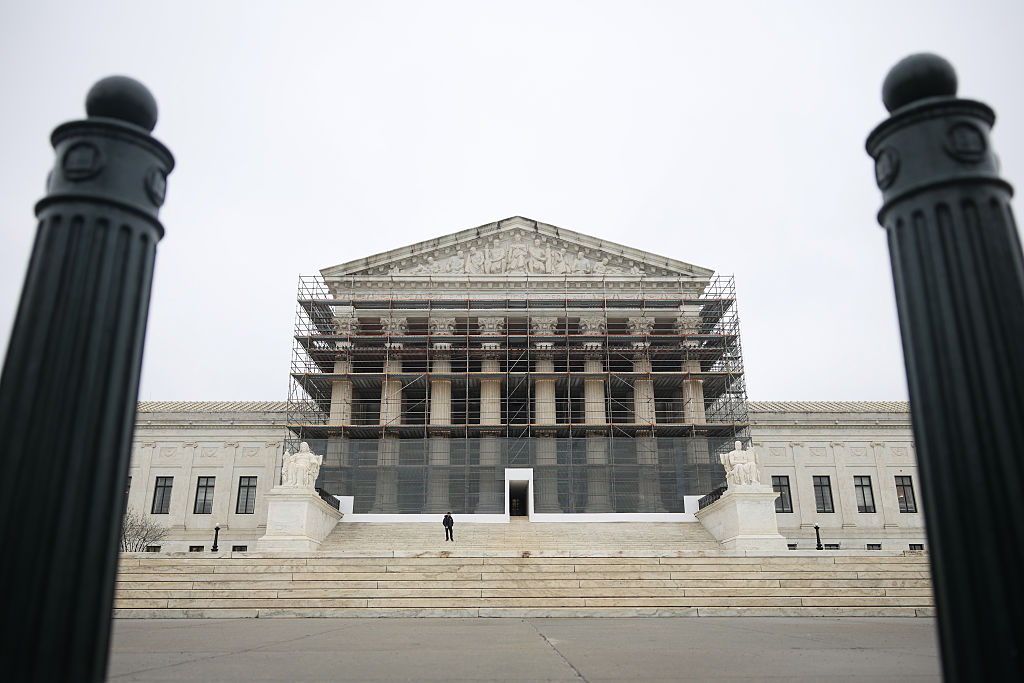Supreme Court to hear arguments in pivotal case on the Voting Rights Act


The Supreme Court will hear oral arguments on Wednesday, Oct. 15, in Louisiana v. Callais, a challenge to the congressional map that Louisiana adopted in 2024 that may reshape the Voting Rights Act. It is the second go-round at the court for this dispute in less than a year; the justices heard arguments in the case for the first time in March, but didn’t decide it during their 2024-25 term. Here is a brief explainer on the long and complicated history of this case.
How did this dispute start?
The dispute began back in 2022, when Louisiana’s Legislature adopted a congressional map with one majority-Black district out of the six seats allotted to the state, although roughly one-third of the state’s population is Black. A group of Black voters went to federal court, where they argued that the 2022 map violated Section 2 of the federal Voting Rights Act, which prohibits election practices that result in a denial or abridgement of the right to vote based on race.
A federal district court agreed with the Black voters that the 2022 map likely violated Section 2, barred the state from using the map for future congressional elections, and directed the state to draw a new plan with a second majority-Black district. The U.S. Court of Appeals for the 5th Circuit upheld that ruling.
In 2024, the Louisiana Legislature drew a new map, known as S.B. 8, that created a second majority-Black district. A different group of voters, who describe themselves as “non-African American,” contended that the 2024 map was an unconstitutional racial gerrymander – that is, that it impermissibly sorted voters based primarily on their race, in violation of the equal protection clause of the 14th Amendment. A three-judge district court agreed with them and barred the state from using the map in congressional elections.
The Supreme Court put the three-judge district court’s decision on hold in May 2024, allowing the state to use the 2024 map in that year’s elections. Voters in the newly drawn district elected Cleo Fields, who had represented a majority-Black district in Congress for two terms during the 1990s until the districts were redrawn, to represent them.
Louisiana and the Black voters who had challenged the 2022 map appealed the three-judge district court’s decision to the Supreme Court, which in November set the case for oral argument.
What was the original question before the justices?
The dispute initially focused on the 2024 map itself – specifically, whether the lower court was correct when it concluded that the second majority-Black district was an unconstitutional racial gerrymander.
What were the litigants’ arguments the first time the court heard this case?
Louisiana and the Black voters defended the 2024 map. Louisiana contended that it was caught between the proverbial rock and a hard place. In the challenge by the Black voters, it argued, the district court had concluded that the 2022 map – with only one majority-Black district – likely violated Section 2. The state therefore opted to draw a new map with a second majority-Black district to comply with the district court’s ruling. But once it made that decision, the state said, its focus shifted to drawing a map that would protect some of the state’s powerful Republican incumbents, including Speaker of the House Mike Johnson and Rep. Julia Letlow, who sits on the House Appropriations Committee.
The Black voters echoed the state’s argument. Because the state says that politics, rather than race, was the focus of its redistricting decisions, they contended, the Supreme Court’s cases require the “non-African-American” voters to meet the “high bar” of showing that race was the primary factor in the Legislature’s decision to enact the map – a showing that, they said, the challengers cannot make.
The “non-African-American” voters told the justices that, as the three-judge district court concluded, it was “utterly implausible” that race and politics played equal roles in the drawing of the 2024 map. The Legislature decided first to draw the second majority-Black district, they said; it was only after that decision had been made, they argued, that Republicans then “had to choose which Republican to sacrifice.” And to the extent that the state’s focus was to comply with the Voting Rights Act, they continued, that just shows that race was the legislature’s main motivation when it drew the second majority-Black district.
Why did the justices decide to hear arguments again?
There’s no way to know exactly why the justices opted to schedule the case for another argument. The brief order that the court issued on June 27, which was the last term’s final day before the justices’ summer recess, simply indicated, without any explanation, that the dispute was “restored to the calendar for reargument” and that “[i]n due course” the court would issue a follow-up order on scheduling and “any additional questions to be addressed in supplemental briefing.”
Justice Clarence Thomas dissented from the decision to hear reargument in the case. In his view, there is an “intractable conflict” between Section 2 of the Voting Rights Act and the equal protection clause of the 14th Amendment of the Constitution. To the extent that the Supreme Court’s interpretation of the VRA violates the 14th Amendment, he wrote, he “would make clear” that “the Constitution controls.”
What is the question before the Supreme Court on Wednesday?
On Aug. 1, the Supreme Court issued an order instructing the litigants to file new briefs addressing “whether the State’s intentional creation of a second majority-minority district violates” either the 14th Amendment, which bars the government from treating similarly situated people differently, or the 15th Amendment, which prohibits the government from denying or restricting voting rights based on race.
What are the litigants’ arguments this time around?
In a brief filed on Aug. 27, Louisiana no longer defended the 2024 map. It told the justices that race-based redistricting – even if done to comply with Section 2 – is unconstitutional. Quoting the Supreme Court’s 2023 decision in Students for Fair Admissions v. President and Fellows of Harvard College, which struck down the use of race in admissions at colleges and universities, the state declared that “[e]liminating racial discrimination means eliminating all of it.” The 14th Amendment, the state contended, “commands that the government ‘may never use race as a stereotype or negative.’ Yet race-based redistricting rests on an invidious stereotype: that all minorities, by virtue of their membership in their racial class, think alike and share the same interests and voting preferences.”
The Black voters continued to defend the 2024 map, which, according to them, “comport[s] with the Fourteenth and Fifteenth Amendment guarantees of equal voting rights and the VRA’s requirements.” . They argued that Section 2 “is the crown jewel of civil rights legislation” and falls within “the heart of” Congress’s authority to enforce the Constitution. Section 2, they wrote, “authorizes some consideration of race” in redistricting, “but only when doing so is required to remedy identified racial discrimination.” If Section 2 is not available to protect Black voters in Louisiana, they cautioned, it will not “end discrimination there or lead to a race-blind society, but it may well lead to severe decrease in minority representation at all levels of government in many parts of the country.”
The “non-African-American” voters argued that Section 2 was “inconsistent with the letter and spirit of the Constitution.” That provision, they contended, does not “eliminat[e] hard-to-reach discrimination,” as its supporters assert, but instead “is now discrimination’s main source and aggravator” by requiring race-based redistricting, which “violates our ‘color-blind’ Constitution.” But even if Section 2 could apply in the abstract without running afoul of the Constitution, they continue, it still violates the Constitution here: The Black voters “have not shown that persistent intentional racial discrimination in redistricting justifies the VRA’s race-based sorting and balkanization of voters into mandated quota districts.”
The Trump administration filed a brief in which it urged the justices to uphold the three-judge district court’s decision. U.S. Solicitor General D. John Sauer told the justices that “Congress enacted the VRA pursuant to its power to enforce the Fifteenth Amendment, which bans only intentional racial discrimination in voting.” Interpreting Section 2 of the VRA to mandate race-based redistricting, Sauer contended, is not required by the text of the provision, and it “would decouple the statute from its function of smoking out voting practices and procedures that are likely intentionally discriminatory and would instead intentionally effectively compel racial gerrymanders.”
How have the stakes changed?
A ruling that strikes down the 2024 map and upholds the lower court’s decision could affect not only Louisiana but also when and how legislatures everywhere in the United States may consider race when drafting new maps. A report by two voting rights groups indicates that if legislators cannot consider race to remedy racial discrimination in voting, the Congressional Black Caucus could lose up to 30% of its members, while the Congressional Hispanic Caucus could lose up to 11% of its members.
Who are the lawyers arguing the case?
Four different lawyers will appear at the court on Wednesday. Two of them return from the first argument in March: Benjamin Aguinaga, the solicitor general of Louisiana, and Edward Greim, representing the “non-African-American” challengers. Janai Nelson, the president of the NAACP Legal Defense Fund, will represent the Black voters defending the 2024 map, while Hashim Mooppan, the principal deputy U.S. solicitor general, will represent the Trump administration.
Who are the justices to watch at Wednesday’s argument?
Two key justices are likely to be Chief Justice John Roberts and Justice Brett Kavanaugh. Both were in the majority two years ago in Allen v. Milligan, in which the court both ruled that an Alabama congressional map likely violates the Voting Rights Act but rejected an invitation to undermine the power of Section 2. Nevertheless, Kavanaugh wrote a concurring opinion in that case in which he signaled sympathy for an argument that Alabama had not made in its filings in the Supreme Court – the idea that, like the use of race in college admissions, “the authority to conduct race-based redistricting cannot extend indefinitely into the future.”
When will the court decide the case?
There’s no way to know when the justices will issue their decision in the case. However, with the state’s primary election scheduled for April 18, 2026, Louisiana’s secretary of state, Nancy Landry, has asked the court to rule quickly – “ideally in December or early January.”
Posted in Court News, Merits Cases
Cases: Louisiana v. Callais (Voting Rights Act), Louisiana v. Callais, Robinson v. Callais